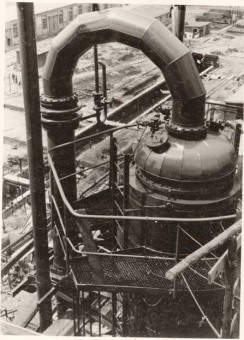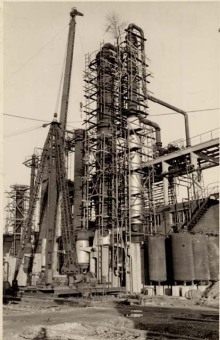I.G. Auschwitz
![“Picture 1 shows a distillation column lying next to a railroad track. It is about 20 m long […]. Visible on the column are a large number of nozzles, to which piping will be attached later, after positioning, during assembly. In the background (center) is construction material in the form of planks and pipes.” '(Photo 1943/44, description by I.G. Farben defense counsel, Wollheim lawsuit, 1955)'© Central State Archive of Hesse (records of Wollheim lawsuit)](/files/1002/margin/HHStA_460_1424_Bd20620Bl201131_01.jpg?1228401448)
(Photo 1943/44, description by I.G. Farben defense counsel, Wollheim lawsuit, 1955)
© Central State Archive of Hesse (records of Wollheim lawsuit)
I.G. Auschwitz, founded in Kattowitz on April 7, 1941, was intended to be the largest chemical factory in Eastern Europe and at the same time a building block in the process of “Germanizing” the region. According to the plan, the production facilities were to supply the Eastern European market with plastics in peacetime, following their use for wartime production. In addition to German skilled workers and forced laborers from all over Europe, increasing numbers of prisoners from the Auschwitz concentration camp were deployed at the gigantic construction site in Auschwitz. In 1942 I.G. Auschwitz built its own corporate concentration camp, Buna/Monowitz.
I.G. Farben’s Choice of Auschwitz as a Plant Site
What Was I.G. Auschwitz Meant to Produce?
What Is Buna? From Natural Rubber to Synthetic Rubber
Buna for the Wartime Economy – Planing and Large-Scale Production in the Years 1933–1945
The Buna External Work Detachment (April 1941 to July 1942)
Employees of I.G. Farben at I.G. Auschwitz
I.G. Farben Master Craftsmen and Foremen in Contact with the Concentration Camp Prisoners
Plant Security at I.G. Auschwitz
Italian “Foreign Workers” at I.G. Auschwitz
East European Women as Forced Laborers for I.G. Auschwitz
Polish Workers at I.G. Auschwitz
E715 – Camp for British Prisoners of War
British Prisoners of War in Auschwitz
British POWs and the Prisoners in the Buna/Monowitz Concentration Camp
Biographies of British Prisoners of War
Closure and Dismantling of I.G. Auschwitz, Further Use of the Factory



















![“In Picture 2, a column is lying at an angle in front of its concrete foudation, with the connection nozzles clearly visible. Two assembly towers have been positioned, with which the column is to be hoisted […] In the foreground of the picture, construction material in the form of stones is visible.”'(Photo 1943/44, description by I.G. Farben defense counsel, Wollheim lawsuit, 1955)'© Central State Archive of Hesse (records of Wollheim lawsuit)](/files/1003/margin/HHStA_460_1424_Bd20620Bl201131_02.jpg?1228401465)
![“Picture 3 shows, at left, three columns that have been positioned, with the assembly towers already removed […] At right in the picture, a scaffolded column is visible, with a number of pipes already installed. The light-colored part, about 3/4 of the way up, is the insulation [...] About 1 m above the planks of the actual work platforms, handrails have been attached so that work can be done on these platforms without belts, but in an accident-proof way.”'(Photo 1943/44, description by I.G. Farben defense counsel, Wollheim lawsuit, 1955)'© Central State Archive of Hesse (records of Wollheim lawsuit)](/files/1004/margin/HHStA_460_1424_Bd20620Bl201131_03.jpg?1228401481)
![“Picture 4 shows these work platforms with their handrails quite clearly, and you also see that besides the handrails, footrails are also attached to the platforms […] At the center of the picture you see, on a platform, the condensers, containers, and the pipework that goes with them, which can be installed without any danger. On the column in front, the vertical ladder is visible, surrounded by a basket that serves as a safety cage.”'(Photo 1943/44, description by I.G. Farben defense counsel, Wollheim lawsuit, 1955)'© Central State Archive of Hesse (records of Wollheim lawsuit)](/files/1005/margin/HHStA_460_1424_Bd20620Bl201131_04.jpg?1228401498)

